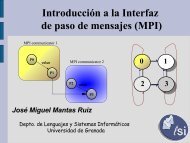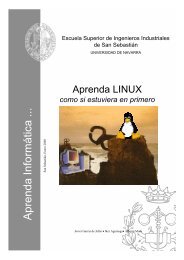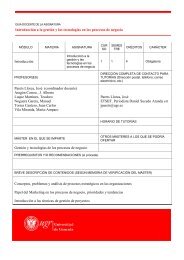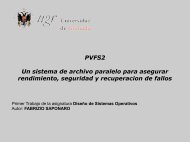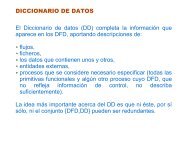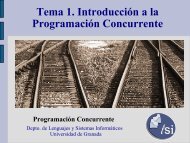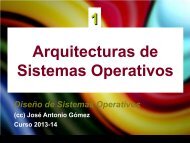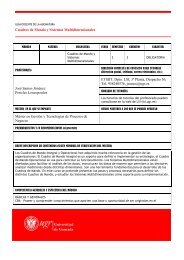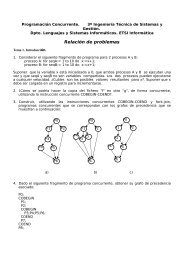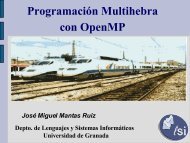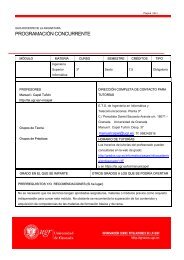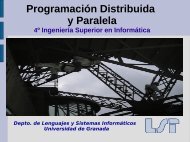design of adaptative videogame interfaces: a ... - ResearchGate
design of adaptative videogame interfaces: a ... - ResearchGate
design of adaptative videogame interfaces: a ... - ResearchGate
You also want an ePaper? Increase the reach of your titles
YUMPU automatically turns print PDFs into web optimized ePapers that Google loves.
DESIGN OF ADAPTATIVE VIDEOGAMEINTERFACES: A PRACTICAL CASE OF USEIN SPECIAL EDUCATIONJ.L. González Sánchez, F.L. Gutiérrez, M.J. Cabrera, N. Padilla ZeaVideogames and E-Learning Research Lab. (LIVE) – GEDES. S<strong>of</strong>tware EngineeringDepartment. University <strong>of</strong> Granada, C/ Daniel Saucedo Aranda, s/n, E-18007, Granada, Spain.E-Mail:{joseluis, fgutierr, mcabrera, npadilla}@ugr.esAbstract: The use <strong>of</strong> new technological and learning methods that help toimprove the learning process has produced the inclusion <strong>of</strong> the <strong>videogame</strong>s as active elements in the classrooms. Videogames are ideal learningtools since they provide training skills, promote independence, increaseand improve students’ concentration and attention. For special educationstudents with learning difficulties, it is very important to adapt the game toeach student’s cognitive level and skills. The present work describes ourexperience in the <strong>design</strong> and the use <strong>of</strong> <strong>videogame</strong>s as new forms to createdidactic learning tools to pupils with serious communication problems asautism, dysphasia, ictus or cerebral palsy.Keywords: Design <strong>of</strong> Videogames, Interactive Systems, User Interfaces,Playability, Special Education.1. IntroductionHumans, through history, have had the ability to administrate their leisuretime and have used this factor as cultural development. According toHuizinga [1], the game with the relationship and abilities that humansacquire with the playing process is one <strong>of</strong> the most important aspects in thehuman social-cultural evolution. Videogames are the XXI th century games.Videogames [2] enable knowledge to be developed through gamecontents and increase cognitive abilities through play, but a specialchild/player has his/her own characteristics that make him/her unique inthe world. In these situation it’s a very important factor that didactical<strong>videogame</strong>s must adapt to the player, not only to the context, also to
2interaction techniques, user interface and the didactical contents to developthe most efficacious didactical <strong>videogame</strong>s.In this paper we will describe our proposal to <strong>design</strong> and develop“player centred <strong>videogame</strong>s” and apply them to a practical context: SpecialEducation. We will describe how to introduce the educational contents intoa game structure and how to readapt the <strong>videogame</strong> interface to make thesecontents and game dynamics (user interface and user interaction) the mostsuitable as possible to users/players. The second section <strong>of</strong> this paperpresents various considerations and ideas about special education<strong>videogame</strong>s and how to develop personalized <strong>videogame</strong>s using our gamearchitecture and <strong>design</strong> techniques. Section 3 presents an example <strong>of</strong> ourideas, a <strong>videogame</strong> to learn the vowels. Finally, Section 4 outlines ourconclusions and future lines <strong>of</strong> work.2. Learning by playing, playing to learn: The Design <strong>of</strong>Adaptative Videogames to the PlayerCan we learn playing <strong>videogame</strong>s? This is a question largely debated byspecialists in psychology and pedagogy. A <strong>videogame</strong> could be an unequalpedagogical tool in special education classroom. We should take intoaccount a series <strong>of</strong> user’s factors in order to get the most effective possibleeducational process when we are <strong>design</strong>ing an educational <strong>videogame</strong>:Motivation, Attention, Concentration and Emotion [3, 4, 5, 6]. But, inSpecial Education field the game must be easy to personalize using theplayer’s cognitive and physical characteristics because every child isunique in the classroom.Our didactical <strong>videogame</strong>s proposal starts from this main idea: Theprincipal child activity must be playing; the consequence <strong>of</strong> this action(playing) will be that the child learns the educative contents in an implicitway.It is essential to <strong>design</strong> and to develop a high quality <strong>videogame</strong> thatthe game process stimulates player’s fun and entertainment. Wedenominate Playability the set <strong>of</strong> properties to describe the player’sexperience with a particular game system, that the principal goal isfun/entertainment to the player in a satisfactory and credible way, playingalone or with other players. Playability reflects the player’s pleasure,experience, sensations and feelings when he/she is playing the <strong>videogame</strong>.In the Design Process, the first step is creating a complete StoryLine. Itmust be attractive to the future players who play the game. A good story
<strong>of</strong>fers a “good connection” between game and player, and helps to catchthe player’s attention and consequently to create crucial motivationmechanisms that guarantee the interest <strong>of</strong> the child to play the game. Thehistory should motivate, excite and thrill the child/player.The following step is the Gameplay Design. It includes all playerexperiences during the interaction (what the player can do and how to do)with game systems. For example: goals, rules, learning curve, etc. Thisterm is used to describe the overall experience <strong>of</strong> playing the gameexcluding the aspects <strong>of</strong> graphics, sound, and the storyline. In GameplayDesign for the Special Education field it is very important to <strong>of</strong>fer afeedback, focused on the cognitive need, for each action. Player’s errorshould be corrected without causing sadness or discouragement. It’srecommendable to use a main character or hero, who acts as amediator/guide in the learning process and game. This learning processshould be in rise, based on multi-levels or missions, where the level <strong>of</strong>difficulty increases gradually. Rewards <strong>of</strong>fer an extra motivationsatisfactionfactor, they allow us to create mechanisms that influence theplayer to self-improvement and advance while playing.In the educational contents <strong>design</strong> it is crucial to identify the player’spr<strong>of</strong>ile, his/her limitations and cognitive capabilities in order to choose thebest interaction and user interface mechanisms. We have to structure andadapt the didactic unit objectives to the player’s characteristics and goals<strong>of</strong> the game. The educational contents should be introduced into the gamestructure in a hidden way.Our main goal is to develop special education <strong>videogame</strong>s that adapt tothe different player pr<strong>of</strong>iles. In order to do that we proposes a s<strong>of</strong>twareevolution framework, based in three-layer structure: the meta-game, themeta-phase and the meta-level. With this meta-structure we model thebehaviour and the functionality <strong>of</strong> our game engine and <strong>videogame</strong>mechanics: interaction, feedback, etc., independently from the player skillsor concepts to be learned.Meta-game layer <strong>of</strong>fers the basic game architecture for training with aspecific child. It has two dimensions: The Accessibility dimension, whichdescribes the user interface and the interaction characteristics according tothe player’s skill pr<strong>of</strong>ile and Gameplay dimension, which defines theprincipal characteristics <strong>of</strong> the game (goals, multi-levels or missions,rewards, etc).Meta-phase layer involves the educational contents. Finally, the Metalevellayer allows defining educational exercises to train the conceptdefined in the specific phase. This game definition is saved in binary files3
4to use them with the game engine to run a specific game. We can use thegame reports to readapt the difficulty <strong>of</strong> levels dynamically, introducingadaptation/personalization rules (e.g.: frequency <strong>of</strong> errors and hits) into thegame engine. A graphical model <strong>of</strong> our <strong>adaptative</strong>/evolutive gamearchitecture is represented in Fig. 1.Fig.1. Adaptative/Evolutive Videogames Architecture3. A Practical Example: Leoncio and the Lost Vowels IslandAs an example <strong>of</strong> <strong>videogame</strong>s using the ideas that we have presented inthis paper, we will introduce our prototype <strong>of</strong> didactical <strong>videogame</strong> appliedto special education: “Leoncio and the Lost Vowels Island” on NintendoDS [2]. The main educational objective is to learn the vowels across therelationship between the stimuli that the game presents. With the correctstimulus we also introduce erroneous stimuli, in these cases the playershould discriminate to obtain the correct result. The game is based onlearning method <strong>of</strong> reading/writing call “SuperLecto-Escritura” [8]. Inevery moment during the game exists parallelism between phoneme, textand pictograms (vowel pronunciation, vowel writing and vowel graphicrepresentation). The development <strong>of</strong> the learning <strong>of</strong> vowels comes throughan incremental way, using for it a multilevel system that is grouped in
5different phases. In each level, thanks to the audio device, the child canidentify the phoneme <strong>of</strong> each pictogram touching on it with the stylus orusing sweeping technique in each possible option, emphasizing thepictogram and the letter to be stimulated. When the child respondscorrectly (he/she correlates pictogram with pictogram, later pictogram withvowel and finally with audio), the game shows an appropriate feedbackand emphasizes the pictogram and audio with the vowel. If the child fails,the game emphasizes the right answer and encourages the child to re-selecta new answer. If the process <strong>of</strong> selection is right, in the following level <strong>of</strong>the vowel-phase, the pictogram will decrease its clarity, appearing theletter, which is “hidden” behind the pictogram. At the end the childcorrelates only the vowel with the pictogram. If the process andassimilation have been right at the end <strong>of</strong> the phase, the child will havebeen able to associate a pictogram with the vowel, thanks to a directtraining and implicitly, the child acquires the concept <strong>of</strong> vowel phonemeand completes the triple association pictogram-vowel-phoneme, the basic<strong>of</strong> reading/writing learning.The game has a life system with a number <strong>of</strong> hearts assigned to theplayers, it is another motivation factor. If Leoncio/player fails, he loseshealth.. An example <strong>of</strong> a game level is represented in Fig. 2.When you work with <strong>videogame</strong>s in special education they have acrucial factor. Children must have to adapt to the game, and this processmakes the learning process more complex. Our <strong>videogame</strong> include an<strong>adaptative</strong> process, because the game could personalize to theplayers/children cognitive/physics requirements for example: theinteraction methods, playability or contents presentation using accessibilitymechanisms to rapidly adapt the game to several cognitive user pr<strong>of</strong>iles.Fig.2. Example Level in “Leoncio and the Lost Vowels Island”
64. Conclusions and Future WorksIn this paper we have presented our proposal <strong>of</strong> player centred <strong>videogame</strong>sfor special education, following the idea “Learning by playing, playing tolearn”. The learning process must be implicit in the <strong>videogame</strong> dynamics.We are <strong>design</strong>ing a visual platform to create evolving <strong>videogame</strong>sfollowing a development process in which aspects as user interface,educational contents, multimedia and interaction methods are described inseparated and incremental steps. To improve the playability and the gameefficacy, we use entertainment devices as Nintendo DS. Finally, we havepresented one <strong>of</strong> our prototypes: “Leoncio and the Lost Vowels Island”.In next months, we will begin an experiment, with a group <strong>of</strong> childrento check the efficacy <strong>of</strong> our method in “special schools” and elementaryschools. We will keep on working in the s<strong>of</strong>tware evolution frameworkdevelopment and <strong>videogame</strong> theoretic model that allow us working withadaptation/personalization techniques. Also, we are working in defineplayability attributes and properties/qualities and use them in the<strong>videogame</strong> s<strong>of</strong>tware development to obtain more fun and playable<strong>videogame</strong>s to play alone or in company.Acknowledgments. This study and work is financed by the Consejería de Educación (EducationDepartment) de la Junta de Andalucía (<strong>of</strong> the Council <strong>of</strong> Andalusia) as a part <strong>of</strong> SC@UT Projectand the F.P.U Programme <strong>of</strong> the Ministry <strong>of</strong> Education and Science, Spain.5. References[1] Huzinga, J.: Homo Ludens. Ed. Alianza (2000)[2] González Sánchez, J. L.; Cabrera, M.; Gutiérrez, F. L. Diseño de Videojuegos aplicadosa la Educación Especial. VIII Congreso Internacional de Interacción Persona-Ordenador (INTERACCION-2007. pp. 35-45 (2007).[3] Malone, T.W. & Lepper, M.R. "Intrinsic Motivation and Instructional Effectiveness inComputer-based Education." In R.E. Snow & M.J.Farr (Eds.) Aptitude, Learning andInstruction. Volume 2: Conative and affective process analyses. pp. 243-286. LawrenceErlbaum Associates, Hillsdale, N. J (1987)[4] Keller, J.M., & Kopp, T.W. An application <strong>of</strong> the ARCS model <strong>of</strong> motivational <strong>design</strong>.In C.M. Regeluth (eds.), Instructional theories in action: Lessons illustrating selectedtheories and models. pp. 289-320. Lawrence Erlbaum Associates. New York (1987)[5] Csíkszentmihályi, M. Flow: The Psychology <strong>of</strong> Optimal Experience. Harper and Row, .New York (1990)[6] Norman, D. A., Emotional Design: Why We Love (or Hate) Everyday Things. BasicBooks, New York (2004)[7] García, C. V; Luciano, M. C., SuperLecto-Escritura. Programa para el aprendizaje de laLectura y Escritura. Ediciones Némesis, S. L. ISBN: 84-922930-8-X



